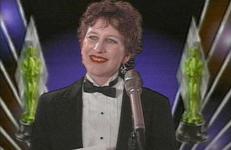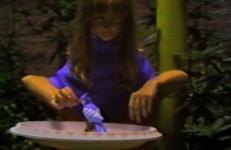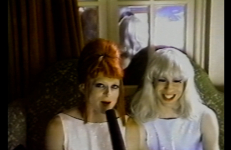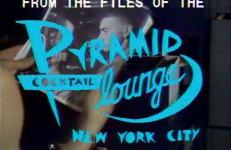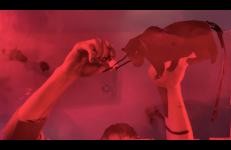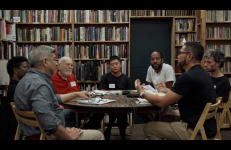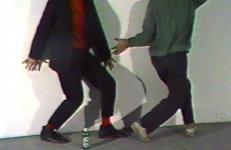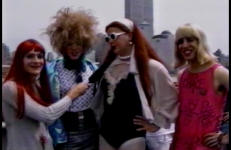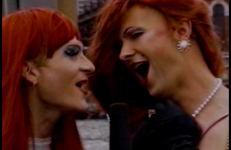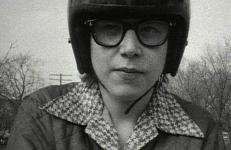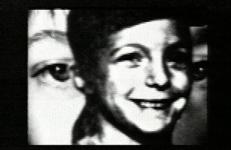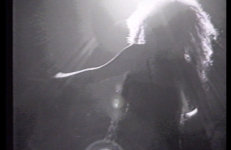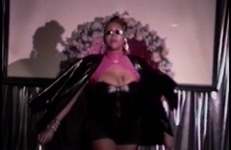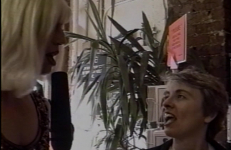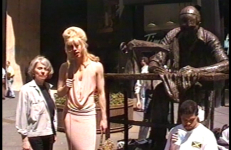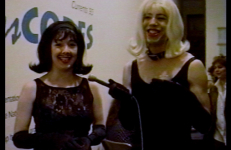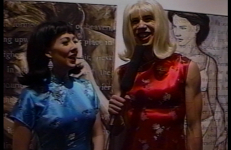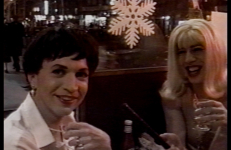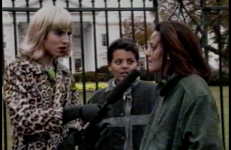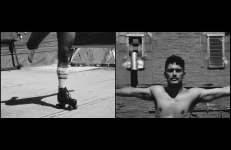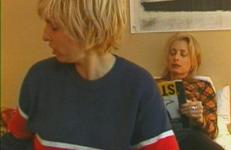Silver directs and performs all the roles in this raucous and hilarious music video rendition of Lynyrd Skynyrd’s "Freebird", the infamous Southern rock anthem for an entire generation of 1970s male youth. In this spoof of straight mass culture, Silver flips ironically between roles; from a lesbian proudly proclaiming her sexuality at the Academy Awards, to an in-concert Coors-drinking Ronnie Van Zant, and, finally, to a black-lace lesbian lounge swinger celebrating the wild, colorful world of “out” visibility.
LGBTQ
Shot in the style of a silent film from the 1920s, Frida & Anita is a political fantasy, intersecting the lives of two queer radicals — Frida Kahlo and Anita Berber — who happen to meet one fateful Berlin night in 1924 at the infamous La Garcon Cabaret.
This first "Frieda" collaboration between performance artists Barbara Lipp and Tom Koden and video artist Tom Rubnitz chronicles Frieda's rise from assembly-line worker in a box factory to singing superstar. Featuring rock-bottom production values and a sound track which includes the Brady Bunch kids' tune "Gonna Find a Rainbow".
This first "Frieda" collaboration between performance artists Barbara Lipp and Tom Koden and video artist Tom Rubnitz chronicles Frieda's rise from assembly-line worker in a box factory to singing superstar. Featuring rock-bottom production values and a sound track which includes the Brady Bunch kids' tune "Gonna Find a Rainbow".
This first "Frieda" collaboration between performance artists Barbara Lipp and Tom Koden and video artist Tom Rubnitz chronicles Frieda's rise from assembly-line worker in a box factory to singing superstar. Featuring rock-bottom production values and a sound track which includes the Brady Bunch kids' tune "Gonna Find a Rainbow".
In From Fagtasia to Frisco, Brenda and Glennda report from Fagtasia, an event honoring the Summer Solstice in New York organized by the Radical Faeries. Through interviews with Faeries and footage of their walk across the Brooklyn Bridge, the group proposes to reclaim the city as a safe space for queer people, and discuss reorienting queer consciousness toward spirituality.
From The Files of the Pyramid Cocktail Lounge is a series of video clips taken at the Pyramid Club, a seminal location for the East Village drag scene in the midst of the club's most influential years. While rummaging through a file cabinet full of event fliers from the Pyramid Club, an office worker in drag guides the viewer through video documentation of past performances at the club.
Future From Inside is the last in the trilogy begun in 2016, by Dani and Sheilah ReStack (also including Strangely Ordinary this Devotion and Come Coyote.) The work traces the ReStack collaboration, as it manifests in life and in work.
Future From Inside is the last in the trilogy begun in 2016, by Dani and Sheilah ReStack (also including Strangely Ordinary this Devotion and Come Coyote.) The work traces the ReStack collaboration, as it manifests in life and in work.
Seven homosexuals, ages ranging 28-85, and strangers to one another, convene in a Los Angeles bookstore. The following unscripted conversation is facilitated by the filmmaker in collaboration with community organizer, founding member of the Radical Faeries, and Jungian psychologist, Dr. Don Kilhefner, and explores community, organizing, identity and intersectionality. Gay Men's Book Club is an intergenerational portrait of a community and the social dynamics found within informal learning environments.
Gay Tape: Butch and Femme is Cecilia Dougherty's first video work. She was immersed in two things at the time: making artwork, and being a part of the Oakland, California lesbian bar scene. The tape is the child of those two activities. Dougherty asked her friends, Ann and Joanne, and her girlfriend at the time, Rosa, to speak on camera about dating and the emergence of butch-femme relationships, which alluded to not so much a regression to old-time lesbian subculture, as to a quotation of those times, and an appreciation of that kind of lesbian eroticism.
This two-part video Gender Cruise on the Circle Line involves Brenda and Glennda leading a group of drag queens, drag kings, and other gender nonconforming people on a three-hour ride on the Circle Line boat around Manhattan.
The two-part video Gender Cruise on the Circle Line involves Brenda and Glennda leading a group of drag queens, drag kings, and other gender nonconforming people on a three-hour ride on the Circle Line boat around Manhattan.
Shot in black and white Super 8, this lyrical short follows a wandering, disengaged youth through grey afternoons. German Song features the hard-edged music of Come, an alternative band from Boston.
Set to music by Bikini Kill (an all-girl band from Washington), Sadie Benning's Girl Power is a raucous vision of what it means to be a radical girl in the 1990s. Benning relates her personal rebellion against school, family, and female stereotypes as a story of personal freedom, telling how she used to model like Matt Dillon and skip school to have adventures alone. Informed by the underground “riot grrrl” movement, this tape transforms the image politics of female youth, rejecting traditional passivity and polite compliance in favor of radical independence and a self-determined sexual identity.
In The Girls at the Dock, Teramana features performers at The Dock, a popular LGBTQ+ bar and nightclub in Cincinnati, Ohio. Teramana engages in backstage banter with the performers before a Tuesday night show, especially with Sirrocco, who was a friend and neighbor of Teramana's, and whom Teramana interviewed for an earlier video piece (Sirrocco). The Dock closed in 2018.
"I never knew Tuesday night could be so much fun... but it sure didn't do much for Wednesday." –Diane Teramana
In Glennda and Bruce Do Times Square, Glennda is taken on a night tour of Times Square by author Bruce Benderson. They observe the dynamic between forms of culture that would typically be identified as “underclass” in “suburbanite” culture within the economic and spatial landscape of New York City. Glennda and Bruce visit the apartment of performer Consuela Cosmetic, who was prolific within New York’s ball scene. She maps out the ways in which she believes gender can be expressed, and discusses the implications of ‘passing’.
In this video, Glennda Orgasm and social critic Camille Paglia walk the streets of downtown Manhattan and discuss the status of mainstream feminism in the early 1990s. They visit the Stonewall Inn, Washington Square Park, and a gay bookstore, and confront a group of anti-pornography protesters.
An episode of Glennda and Friends, hosted by Glennda Orgasm and Camille Paglia. Featuring The Centaurians, Brian Roach, and Rennard Snowden.
In this video, Glennda is joined by social critic and feminist scholar Camille Paglia in New York's fashion district. The pair visit designers studios to discuss their respective styles and creative processes. Additionally, Glennda and Camille explore fashion's relationship to gender and feminism, ultimately recreating an iconic scene from Breakfast at Tiffany's.
An episode of Glennda and Friends, hosted by Glennda Orgasm and Camille Paglia.
In this video, Glennda and sex activist Chris Teen attend the opening of Dress Codes at Boston's Institute of Contemporary Art. They interview museum staff, artists, and other attendees to explore how an exhibition centered upon gender nonconformity will be received by both queer communities and the general public. Glennda and Chris Teen discuss the importance of visibility for marginalized communities, and tap into gender discourses as they existed in the early 1990s.
In this video, Glennda Orgasm and Chris Teen travel to Washington, DC to attend a feminist art exhibition titled Walk the Goddess Walk at the District of Columbia Arts Center. The pair talk to the owner of the gallery, artists included in the show, and attendees, including Francy Caprino, Teena Cromwell, Andrew Melon, Camille Paglia, and Joseph Virgilio.
An episode of Glennda and Friends, hosted by Glennda Orgasm and Chris Teen.
In this video, Glennda and Judy LaBruce (Bruce LaBruce) visit the auction house Christie's East on New York's Upper East Side to view Judy Garland memorabilia that is being auctioned off. They attempt to rescue Garland's Oscar from those trying to profit from the auction.
An episode of Glennda and Friends, hosted by Glennda Orgasm and Judy LaBruce.
In the video Glennda does DC, Glennda interviews people in Washington D.C. about the topic of gay rights. As the National Gay and Lesbian Task Force Conference is going on simaltaneously, she asks people if they were aware of this, and if they believe that there should be a gay rights bill.
A film titled Dance Movie (or, alternatively, Rollerskate) appears in many Warhol filmographies, but no work with this title has been found in the archive. The lost film, starring dancer Fred Herko, was shot in 1963. A year later, Herko leaped out of an open window while dancing to Mozart’s Coronation Mass in C Major. Inspired by descriptions of the missing film and the memoir of Herko’s best friend, the poet Diane Di Prima, Goddess of Speed poetically reimagines the last days of the young performer.
Gone is a two-channel installation based on the second episode of An American Family — the landmark PBS verité documentary about the Loud Family of Santa Barbara, California. Dougherty has created a free-form variation on the theme of parental visits to wayward queer children by mapping the dialogue and plot onto a contemporary community of artists and writers in New York today, paying homage to the art underground and the city itself.




